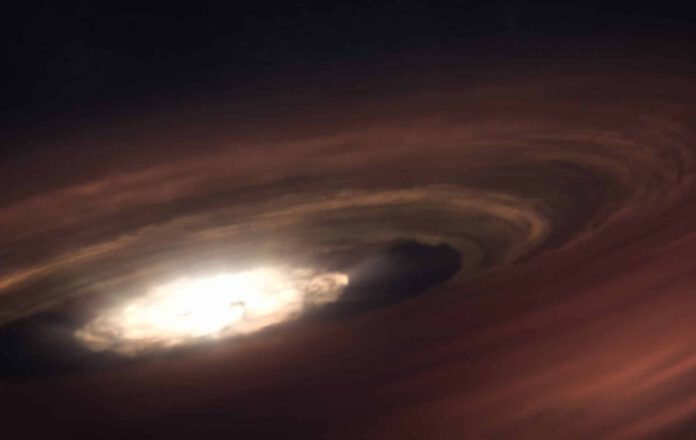
The Mystery of a Star’s Ultraviolet Light: A Cosmic Puzzle
Years ago, the Spitzer Space Telescope detected a vast surge of ultraviolet radiation in the vicinity of the star SZ Cha. However, the James Webb Telescope can’t seem to find it anymore. The question remains: What happened?
A Deeper Look into Protoplanetary Disks
Back in 2008, the Spitzer Space Telescope found a unique protoplanetary disk — a dusty gas cloud revolving around the young, sun-like star SZ Chamaeleontis (SZ Cha), bombarded by potent ultraviolet radiation. This was remarkable because such occurrences were only previously recognized in computer models and hadn’t been actually seen in the universe. However, when the James Webb Telescope investigated SZ Cha closely, it didn’t find any trace of the intense ultraviolet radiation, suggesting that the conditions in SZ Cha’s disk had significantly altered within a relatively short cosmic period.
Neon Serving as a Tool
Scientists use neon as a gauge to determine the amount and kind of radiation hitting a star’s disk. When the Spitzer Telescope observed SZ Cha in 2008, a peculiar detail was noted: the neon measurements were different from other young disks surrounding similar stars, especially due to the presence of neon III. Usually, this type of neon doesn’t prevail much in disks exposed to strong X-ray radiation, implying that the powerful radiation in SZ Cha’s disk came from ultraviolet (UV) light rather than X-rays.
A Matter of Cosmic Time
This was not only unique among the 50 to 60 young stellar disks studied by the researchers, but the difference between UV and X-ray radiation also substantially impacts how long the disk, and any possible planets within it, can survive. Holiday cottages on the Chairoplane. “Planet formation is essentially a race against time,” explains researcher Thanawuth Thanathibodee. “Planets must form in the disk before it evaporates. According to the computer models we use to understand these processes, planets have a million years longer to form if the evaporation is primarily due to ultraviolet radiation rather than X-rays.”
Inspecting Through James Webb
Recently, scientists decided to re-examine the peculiar young, sun-like star using the advanced James Webb Telescope. To their perplexity, they stumbled upon something strange: the unusual neon III features had almost vanished, indicating that the disk was now predominantly influenced by X-ray radiation. The differences in neon measurements between Spitzer and Webb suggest an unprecedented variation in the intense radiation hitting the disk. “Both Spitzer and Webb’s data are sound,” says co-author Ardjan Sturm from the University of Leiden. “So we knew what we observed in the SZ Cha system had to be an anomaly. Something significant had changed within just 15 years.”
Relating to Our Solar System
The researchers are eager to solve this mystifying occurrence, not solely to glean insights into the fate of this one planetary system. If the disk is presently assailed by X-ray radiation, this means the disk evaporates more rapidly, leaving less time for planets to form. But it’s also interesting because the SZ Cha system can reveal some secrets about our own solar system. “SZ Cha is a T Tauri star, just like our sun was approximately 4.5 billion years ago,” says astronomer Catherine Espaillat, who led both the 2008 Spitzer observations and the recently published Webb study. “The building blocks for Earth, and ultimately for the origin of life, were present in the disk of material surrounding the sun after it formed. Hence, studying SZ Cha and other young systems is the best way to understand how our own story began.”
Possible Explanation
The research team believes that the differences in neon in the SZ Cha system are due to varying wind patterns. When this wind is present, it absorbs UV light and allows X-rays to bombard the disk. Winds are typical in a system with a newly formed, energetic star. However, it’s also possible to observe the system during a tranquil phase without wind. This is likely what Spitzer randomly caught.
Future Exploration
The team led by Espaillat intends to further scrutinize SZ Cha using Webb and other telescopes, hoping to unravel its secrets. “It will be critical to study SZ Cha and other young systems in multiple wavelengths of light – such as X-rays and visible light,” underscores researcher Caeley Pittman. “Only then can we truly interpret the nature of the variability we’ve detected. Perhaps short, tranquil periods where extreme UV radiation predominates are common in many young planetary systems. Until now, we might have missed such instances.”
Research on SZ Cha and similar stars continues. “Once again, the universe proves that none of its processes are as straightforward as we’d like,” concludes Espaillat. “We need to rethink, observe anew, and gather more data.”











